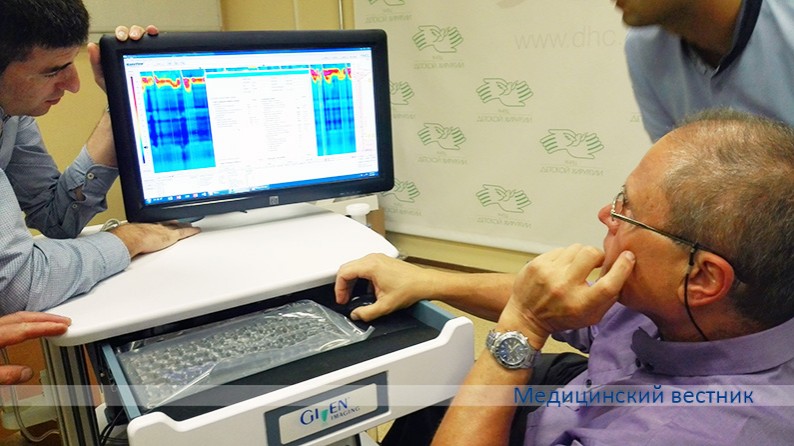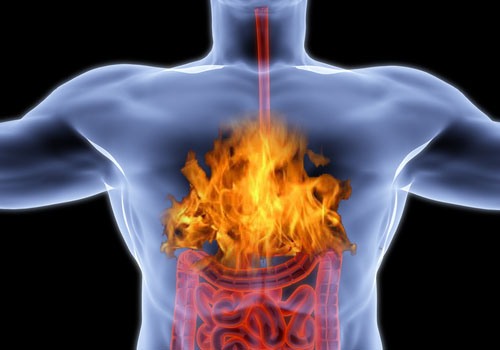The system for esophagomanometry appeared in the Children’s Surgery National Applied Reseach Hospital (CSNARH). The specialists of CSNARH are the first in CIS-countries to use it in practice.
A training seminar on modern diagnostic algorithms of motility disorders in the gastrointestinal tract and gastroesophageal reflux disease was devoted to the implementation of the methodology. Ron Yishai, Head of the Neurogastroenterology Section, Department of Gastroenterology and Hepatology of the Medical Center Ichilov, the major Israel clinic, was the speaker of the Seminar.
ESOPHAGOMANOMETRY is indispensable to diagnose conditions such as gastric reflux, difficulty in swallowing, functional chest pain, achalasia, hiatal hernia. It is easier to control the treatment with its help. – The new equipment may be used in pre-operative evaluation in patients who are being considered for surgery, – points Kirill Marakhovsky, the head of the Diagnostic Department of CSNARH . – The decisions made not on instrumental diagnostic methods became obsolete. Annually around 30 children with GIT motility problems are being operated in CSNARH. It is rather complicated to diagnose this pathology, but we must be sure for 100%.
A flexible plastic tube of one-eighth inch in diameter is passed through the nostril into the esophagus as the patient swallows small portions of water. The procedure usually takes not more than 20 minutes and doesn’t need hospitalization. In children one nostril is anesthetized with a numbing lubricant.
Due to 432 control points we have a holistic picture of what is happening in the esophagus.
The system determines the pressure in the sphincter system of the gastrointestinal tract, peristaltic motions, esophagus overacidification period, anorectal pressure, etc.
There are several blocks in the equipment: except manometry, there is a pH-metry and a special radio-frequency capsule that is attached to the wall of the esophagus and transmits all data without a probe. A similar equipment for manometry has been used for a year at the 2nd Department of Internal Diseases of the Belarusian State Medical University.
The Seminar lasted 2 days and gathered around 50 specialists. The speaker highlighted the theoretical issues of pH-monitoring, impedance-pH-metry, esophageal and anorectal manometry, together with clinical cases.
Under the guidance of Ron Yishai, the specialists from CSNARH have conducted the first diagnostics on the new equipment. The case is very difficult: it has not been possible to help the patient effectively for many years. The problems with motility of the gastrointestinal tract (presumably gastroesophageal reflux disease) began at the age of three. Six Nissen fundoplications were done. After the fifth intervention, a paresisophageal hernia developed, another operation was performed with the installation of a fundoplication cuff and a mesh implant. After the treatment achalasia-like clinic was observed. 10 sessions of endoscopic balloon dilatation of the cardiac sphincter were performed (the last balloon was 30 mm). The effect after each procedure lasted about a month.
The therapy with botulinum toxin was performed (the first injection was 50 units). Clinical improvement was observed for about two months. Five sessions took place at intervals of three months.
The esophageal manometry was necessary to determine the further tactics of treatment.

Photo by Viktoria Lebedeva, Medicinskiy Vestnik (Medical Herald)
Comments
Ron Yishai,Head of the Neurogastroenterology Section, Department of Gastroenterology and Hepatology of the Medical Center Ichilov (Israel):
We’ve considered an extremely complex clinical case. Unfortunately, the search for an optimal clinical solution for such severe patients is usually delayed. During the examination of the girl we haven’t seen the motility of her gastrointestinal tract at all (the indices are zero).
Manometry allows to narrow the diagnostic search. Every time we must strive for a non-operational way to solve the problem. In this situation, radical actions have been so far postponed, there have been quite a lot of interventions. But if the patient cannot eat, you will have to think about the operation. We have discussed gastro shunting, but this is an extreme case.
Now you need to work with the girl’s psychological status. She is exhausted, suppressed, some mental features are due to a long illness.
This group of patients needs a correction of nutrition to determine the psychological stability. The diet should be adapted to the problem of motor skills; semi-liquid food is preferable. To fill the calorie deficit, high-energy, protein mixtures, if necessary enteral nutrition, are required. If the disorder worsens, you will need a gastrostomy.
Sometimes we prescribe prokinetics in such situations – they are able to “wake up” the digestive tract (although they are usually used for constipation). This group of drugs works all over the gastrointestinal tract.
When analyzing the data, the doctor sees a complete mapping of the motor activity of the esophagus.
The data are presented in the space-time graphs; the indicators are “filtered” depending on the pathology.
The article is taken from the site of the newspaper Medicinskiy Vestnik (Medical Herald)





